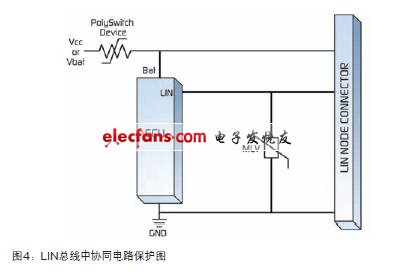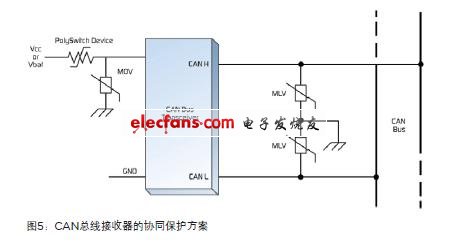Network applications can be physically connected via wire harnesses. Most built-in controllers, built-in or plug-in multimedia, and wireless network functions are powered directly from the car battery or through the ignition switch. The increasing number of sensitive in-vehicle electronic equipment is susceptible to the electrical system itself, human interference or load rejection changes. New passenger cars, trucks, buses, and even motorcycles have become mobile networks, connecting many features and functions, such as built-in control, mobile media, and wireless networks. Applications for infotainment systems, telematics, security control, etc. require the use of several existing network standards, such as LIN, CAN, MOST, IDB-1394, FlexRay, Byteflight, built-in control Bluetooth, and other standards. Figure 1 shows the most common power rail transients, from severe low-high energy to high-low energy transients. Of particular concern is that the transient changes on these power supply systems should meet the ISO7637-2 and ISO10605 standards. Load dump and jump start have produced the most energy transient. When the car starts, it will produce a 6V transient mutation, causing the power supply voltage to drop to 6V. When the alternator generates a charging current, the rechargeable battery is disconnected from the alternator, thereby generating load dump. The peak potential of + 100 / -150V is due to the ignition procedure when electrically burning a gasoline mixture. The frequency of the peak potential depends on the number of cylinders and the rotational speed sent to the engine. Sudden changes in overvoltage that exceed the battery voltage will cause a 24V jump start transient. The battery inversion transient is caused by inadvertently inverting the battery. Figure 2 shows that the transients generated on the data lines are mainly ESD surges. Although such surges are low energy, they generate powerful electromagnetic fields. Table 1 lists several network applications and devices commonly used by Tyco Electronics to prevent circuit damage. Data lines may include media transmission lines, data buses, and sensor data lines. Special attention should be paid to compliance with AEC-Q and ISO 10605 standards. The ISO10605 ± 25kV ESD surge test can be applied to the entire system and can mimic the ESD effects of human contact with surrounding electronic modules. The AEC-Q standard focuses on device strength, including human body model testing, mechanical model testing, and charging device model testing (AEC-Q200 is for passive components and AEC-Q101 is suitable for discrete semiconductors). To avoid damage to the network and connecting components caused by the above-mentioned various over-current, over-voltage or over-temperature conditions, complex design requirements are put forward for both car manufacturers and component suppliers. LIN topology: circuit protection measures In the case of 12V DC, the bus speed for single-line operation reaches 20kbps, and LIN (Local Internet) provides a low-cost vehicle network and supplements the existing vehicle-borne network. Typical applications for LIN include switches, actuators (such as window lift door lock modules), body control electronics to adjust comfort (such as doors, steering wheels, seats and sight glass modules), and motors and sensors (such as constant temperature air conditioning, lighting, wipers Sensors, smart wipers, smart alternators and switch panels). The LIN bus topology uses an independent host or ECU (Electronic Control Unit) and multiple nodes, as shown in Figure 3. Connect the application module to the vehicle network to enable diagnosis and service. Unless explicitly stated in the LIN standard, all voltages can refer to the local ECU grounding and positive current flows into the ECU. If there is an integrated resistor / diode network, no parasitic current path can be formed between the main line and the internal power supply (VSUP) of the ECU. This will affect the ESD surge containment equipment in the circuit. The LIN bus standard requires that when the LIN main line is short-circuited due to a positive voltage less than 26.5V or grounded, the network should resume normal operation. The ESD surge resistance on the physical layer must meet the minimum discharge voltage level of ± 2kV according to the requirements of IEC61000-4-2. However, a level of ± 8kV may appear on the ECU connector. Over-current protection is required to limit over-current when a fault or overload occurs. At the same time, it is also necessary to limit voltage spikes or stable overvoltage conditions through circuit protection equipment. Figure 4 is a coordinated circuit protection diagram showing how a resettable PolySwitch device placed at the power input protects the ECU and LIN node connectors from overcurrent conditions at the power input, and an MLV (multilayer voltage sensitive resistor) How to provide the overcurrent protection required for high current processing and energy absorption for vehicle network applications. CAN topology: circuit protection measures The CAN (Control Domain) standard has the characteristics of medium speed (high-speed CAN reaches 1Mbps). Single-channel, two-wire and fault-tolerant, this protocol is the most commonly used vehicle bus design, but it is also used in many other industries. CAN bus transceivers can allow bus supply voltages up to +/- 80V DC. However, load dump surges can generate higher transients than those specified in the ISO-7637-2 standard (maximum 86.5V), which can damage the transceiver. The operating current of the transceiver also varies from supplier to supplier. Figure 5 shows how to apply resettable PolySwitch devices and MOVs (metal oxide voltage varistors) to the power input to avoid damage due to inrush current and voltage anomalies in the center of the vehicle's power supply system. The two MLVs on the CAN receiver I / O can provide lower capacitance shunt protection and avoid the effects of electromagnetic radiation (EME) caused by common-mode voltage steps. Tyco's automotive-grade PolySwitch devices meet the strict requirements of AEC-Q200 and SAE2685, and have a wide range of electrical characteristics and structural factors to provide the most effective protection scheme. PolySwitch devices, like traditional fuses, block dangerously high currents when they fail. However, unlike the traditional fuse, it can be automatically recovered after the fault is removed and the circuit is restarted. Another advantage is that it has a relatively flexible structural factor, so that it can be directly installed on the circuit board and set inside the electronic module, junction box and power distribution center. Tyco Electronics' MOV equipment can be installed in parallel with equipment or protected components. If an overvoltage condition occurs, the MOV device quickly transitions from a high-impedance state to a low-impedance state, thereby reducing the transient voltage on the component to a safe operating level. Under normal operating conditions, overvoltage equipment is high-impedance equipment and should not affect the operation of conventional systems. The device's low leakage function can also improve the battery's discharge rate.
Modular Wall Switch And Socket Modular Wall Switch And Socket,Modular Light Switch,Modular Hue Wall Switch,Modular Smart Wall Switch ZHEJIANG HUAYAN ELECTRIC CO.,LTD , https://www.huayanelectric.com




